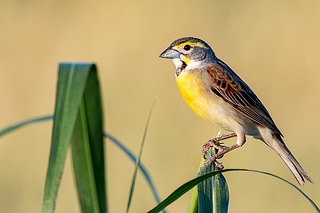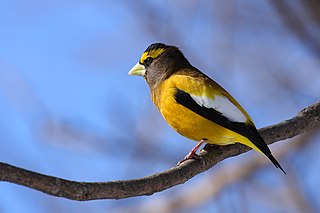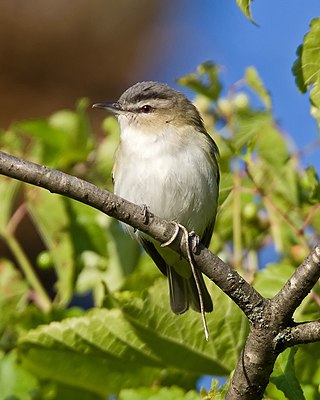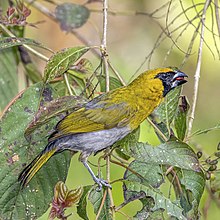
Cardinalidae is a family of New World-endemic passerine birds that consists of cardinals, grosbeaks, and buntings. It also includes several other genera such as the tanager-like Piranga and the warbler-like Granatellus. Membership of this family is not easily defined by a single or even a set of physical characteristics, but instead by molecular work. Among songbirds, they range from average-sized to relatively large, and have stout features, some species with large, heavy bills.

The evening grosbeak is a passerine bird in the finch family Fringillidae found in North America.

The pine grosbeak is a large member of the true finch family, Fringillidae. It is the only species in the genus Pinicola. It is found in coniferous woods across Alaska, the western mountains of the United States, Canada, and in subarctic Fennoscandia and across the Palearctic to Siberia. The species is a frugivore, especially in winter, favoring small fruits, such as rowans. With fruit-crop abundance varying from year to year, pine grosbeak is one of many subarctic-resident bird species that exhibit irruptive behavior. In irruption years, individuals can move long distances in search of suitable food supplies, bringing them farther south and/or downslope than is typical of years with large fruit crops.

The orchard oriole is the smallest species of icterid. The subspecies of the Caribbean coast of Mexico, I. s. fuertesi, is sometimes considered a separate species, the ochre oriole or Fuertes's oriole.

The red-eyed vireo is a small American songbird. It is somewhat warbler-like but not closely related to the New World warblers (Parulidae). Common across its vast range, this species is not considered threatened by the IUCN.

The field sparrow is a small New World sparrow in the family Passerellidae. It is about 140 mm (6 in) long and weighs about 12.5 g (0.4 oz). The head is grey with a rust-coloured crown, white eye-ring and pink bill. The upper parts are brown streaked with black and buff, the breast is buff, the belly is white and the tail is forked. There are two different colour morphs, one being greyer and the other more rufous.

The Japanese grosbeak or Ikaru is a finch native to the East Palearctic. It is also sometimes referred to as the Japanese or masked hawfinch due to superficial similarities to the well-known Eurasian species.

The crimson-collared grosbeak is a medium-size seed- and leaf-eating bird in the same family as the northern cardinal, Cardinalidae.

The grey-headed parakeet is closely related to the slaty-headed parakeet which together form a super-species. It is found in Southeast Asia from north-eastern India to Vietnam.

The scarlet-rumped cacique is a passerine bird species in the New World family Icteridae. It breeds from eastern Honduras to Panama and in the Pacific lowlands of South America from western Colombia south to Ecuador, and in the lower reaches of the northern Andes. There are several subspecies, some of which have been proposed for elevation to full species status.

The black-headed saltator is a seed-eating bird in the tanager family Thraupidae. It breeds from central Mexico to eastern Panama.

The black-thighed grosbeak is a large seed-eating bird in the family Cardinalidae, which is endemic to the mountains of Costa Rica and western Panama.

The lesser greenlet is a small passerine bird in the vireo family. It breeds from northeastern Mexico south to western Ecuador.

The squirrel cuckoo is a large and active species of cuckoo found in wooded habitats from northwestern Mexico to northern Argentina and Uruguay, and on Trinidad. Some authorities have split off the western Mexican form as the Mexican squirrel-cuckoo.

Bursera simaruba, commonly known as gumbo-limbo, copperwood, almácigo, chaca, West Indian birch, naked Indian, and turpentine tree, is a tree species in the family Burseraceae, native to the Neotropics, from South Florida to Mexico and the Caribbean to Brazil, Nicaragua, and Venezuela. Bursera simaruba is prevalent in the Petenes mangroves ecoregion of the Yucatán, where it is a subdominant plant species to the mangroves. In the United States, specimens may be found in the Gulf of Mexico along the western coast of Florida.

The collared grosbeak is a species of finch in the family Fringillidae. Its range encompasses the northern regions of the Indian Subcontinent, mainly the Himalayas, along with some adjoining regions. It is found in Bhutan, India, Myanmar, Nepal and Thailand. Its natural habitat is mountainous deciduous or mixed forests.

The yellow-green grosbeak is a species of grosbeak in the family Cardinalidae.
The grey-headed imperial pigeon is a species of bird in the family Columbidae. It is endemic to Sulawesi in Indonesia. Its natural habitats are subtropical or tropical moist lowland forests and subtropical or tropical moist montane forests.

The black-striped woodcreeper is a species of bird in the subfamily Dendrocolaptinae of the ovenbird family Furnariidae. It is found in Colombia, Costa Rica, Ecuador, Nicaragua, and Panama.
Cymbopetalum mayanum is a species of plant in family Annonaceae. The specific epithet mayanum refers to the Mayan region in which it is indigenous, specifically the Atlantic lowlands of Guatemala and Honduras. It grows as a tree. It is endangered due to habitat loss from agriculture.




















